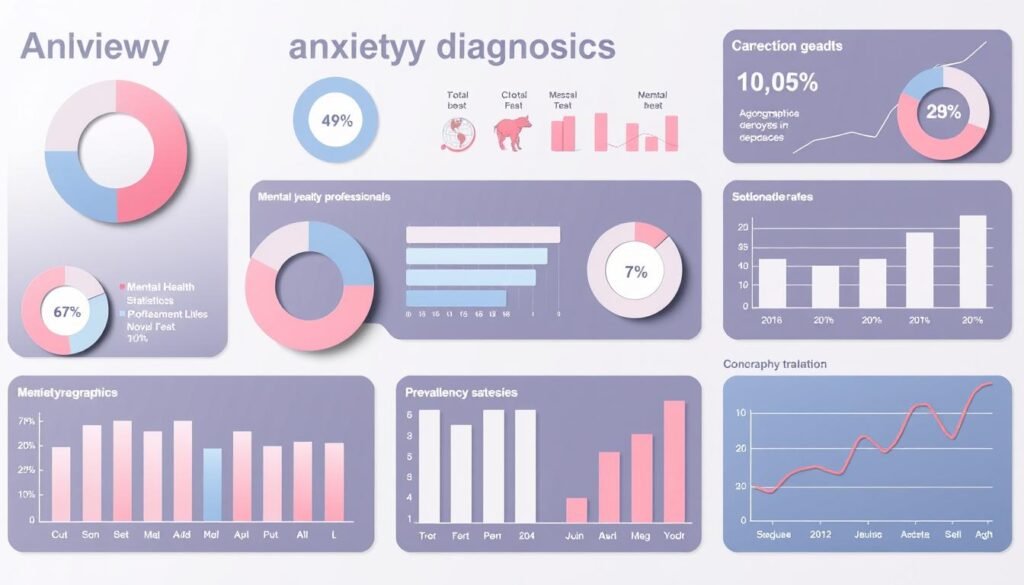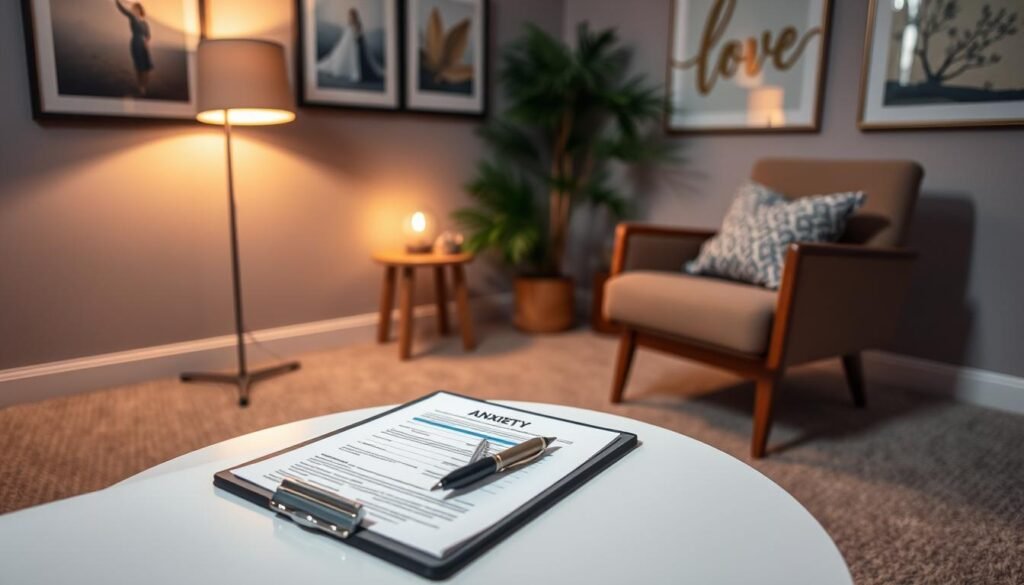Have you ever thought that your view of anxiety could be a barrier? Getting the right help involves more than knowing symptoms. It means overcoming the idea that you should deal with mental health issues by yourself. This guide will help you understand the steps for a professional anxiety diagnosis. It gives you the tools needed for a complete evaluation of anxiety. Realizing the need for a professional’s help is the first key step in managing anxiety well.
Key Takeaways
- Professional diagnosis is essential for effective anxiety management.
- Psychotherapy, particularly cognitive behavioral therapy (CBT), is highly effective.
- Medications can play a vital role in alleviating anxiety symptoms.
- Lifestyle changes, such as exercise and healthy eating, can support anxiety treatment.
- Preparing for appointments helps provide doctors with crucial information.
- Understanding the DSM-5 criteria aids in recognizing anxiety symptoms.
Understanding Anxiety Disorders
Anxiety disorders are a major mental health issue in the U.S., impacting about 40 million adults each year. It’s key to know the different types of anxiety disorders for effective help and support. Not just adults, but also about one-third of kids or teens face anxiety at some point. Let’s look into the various anxiety disorders and their common signs.
Types of Anxiety Disorders
There are several types of anxiety disorders, each with its own characteristics:
- Generalized Anxiety Disorder (GAD): Marked by ongoing, extreme worry about daily life aspects, affecting nearly 7 million American adults.
- Panic Disorder: Features repeated panic attacks, with roughly 6 million Americans affected, occurring more often in women.
- Social Anxiety Disorder: This affects about 15 million U.S. adults and involves a deep fear of social settings, equally among genders.
- Obsessive-Compulsive Disorder (OCD): Known for unwanted thoughts and repetitive actions.
- Specific Phobias: Involves severe fears of particular objects or situations, greatly disrupting everyday activities.
Common Symptoms of Anxiety
Knowing the signs of anxiety disorders is vital for seeking help when needed. Symptoms can appear both physically and mentally, such as:
- Constant worrying that messes with daily life.
- Feeling restless or on edge.
- Signs like a fast heartbeat, sweating, or shaking.
- Hard time focusing or blanking out.
- Feeling very upset, which can cause avoiding certain places or situations.
If you notice these signs, getting help early can really make a difference. Learning about the early signs is helpful for getting support. For more on the physical signs of anxiety and tips on recognizing them, check out this resource.
Signs of Anxiety to Watch For
It’s important to know the signs of anxiety. It helps people understand their feelings and take action early. We will look at how anxiety shows up in both the body and mind.
Physical Signs of Anxiety
Physical symptoms of anxiety can be scary. They might include:
- Rapid heartbeat, which feels like your heart is racing.
- Muscle tension that makes you stiff or sore.
- Sweating a lot when you’re nervous or scared.
- Jitteriness and shaking.
- Difficulty concentrating because your thoughts won’t slow down.
- Sleep disturbances like trouble falling or staying asleep.
These symptoms happen because of stress hormones, like adrenaline and cortisol. They’re common during panic attacks, which can last a few minutes.
Emotional and Behavioral Signs
Anxiety also affects your emotions and behavior. Look out for:
- Irritability, which happens a lot in tense moments.
- Avoidance of people or places that make you feel scared.
- Persistent worry, a sign of Generalized Anxiety Disorder (GAD).
- Feeling overwhelmed by small and big things alike.
Noticing these signs early is crucial. It helps you manage your anxiety better. This might mean trying self-help tips, therapy, medicine, or a mix of these.
How to Get Diagnosed with Anxiety
Getting diagnosed with anxiety involves important steps. It starts with noticing your symptoms and then talking to doctors. Sharing everything during check-ups is key for a good diagnosis.
Steps for Seeking a Diagnosis
Start your journey to an anxiety diagnosis with these steps:
- Document Symptoms: Keep a record of your anxiety and any physical or mental changes. This helps a lot in consultations.
- Consult a Primary Care Provider: The first step is seeing your regular doctor. They might do a check-up and send you to a specialist.
- Engage in Structured Evaluations: Next, you might answer questions or fill out forms about how you feel. This helps measure your anxiety.
- Follow-up on Recommendations: After finding out the cause of your anxiety, you’ll get advice on treatment or more tests to confirm everything.
Knowing the steps to get diagnosed with anxiety is crucial. It shows how to reach mental health support.
Who Can Diagnose Anxiety?
Many professionals can help diagnose anxiety disorders. It’s important to know their roles when looking for professional anxiety diagnosis and treatment. Identifying the right professional is the first step in tackling mental health issues.
Role of Primary Care Providers
Primary care providers are often the first ones we turn to for anxiety symptoms. They can do an initial check and talk about the symptoms we’re facing. They make sure other medical issues aren’t causing our anxiety. They can also send us to specialists like psychiatrists or psychologists for more detailed check-ups.
Mental Health Professionals: Psychiatrists and Psychologists
Psychiatrists are key in diagnosing anxiety disorders. They use specific tests and scales to understand how severe or frequent our symptoms are. Anxiety can show up as constant worry, physical signs like a fast heartbeat or shaking, and sudden fear.
Psychologists, meanwhile, focus on treating anxiety with therapy. Cognitive Behavioral Therapy (CBT) is especially effective for many people. Both types of experts are crucial for dealing with anxiety disorders properly.

| Professional | Role in Diagnosis | Typical Actions |
|---|---|---|
| Primary Care Provider | Initial assessment and referral | Preliminary symptom discussion, ruling out medical issues |
| Psychiatrist | Detailed diagnosis through testing | Administer rating scales, prescribe medications |
| Psychologist | Therapy-based diagnosis and treatment | Implement psychotherapy techniques, focus on coping strategies |
The Initial Consultation Process
An initial consultation is key when looking for advice on anxiety disorders. It helps get ready for a diagnosis. Being well-prepared makes the meeting with your doctor more valuable. It results in a clearer evaluation of your anxiety.
Writing down your symptoms, what causes them, and any medicine you’ve taken helps a lot. This organization makes it easier for both you and the healthcare provider.
Preparing for Your Appointment
At the first visit, it’s crucial to bring information about your anxiety. It’s about looking back and noting important details such as:
- History of symptoms: Note when they started, how severe they are, and how often they happen.
- Triggers: Point out what makes your anxiety worse.
- Medical history: List any medicines you’re taking or have taken, even if they’re over-the-counter.
- Lifestyle and habits: Think about how your sleep, exercise, and diet influence your anxiety.
- Family history: Be ready to talk about if anxiety or mental health issues run in your family.
Questions to Expect from Your Doctor
In the consultation, the doctor will ask many questions to understand your situation better. Getting ready for these questions makes for a good talk. You might be asked:
- What specific symptoms are you feeling?
- How long have these symptoms been bothering you?
- Do certain things make your anxiety worse?
- Have you tried any treatments for anxiety before, and what were the results?
- Is there a history of anxiety or mental health issues in your family?
What to Expect During an Anxiety Evaluation
Anxiety evaluations are in-depth checks. They measure how anxiety affects your daily life. Doctors use many tools to understand your mental health better. This step is key to finding the right treatment plan.
Psychological Assessments and Questionnaires
The evaluation includes standardized tests. These help measure your anxiety levels. These tests are:
- Generalized Anxiety Disorder Assessment (GAD-7): Rates how you’ve felt over the last two weeks. The scale goes from “never” to “almost every day.”
- Hamilton Anxiety Rating Scale (HAM-A): Rates your anxiety symptoms. The score goes from 0 to 56 to show how severe your anxiety is.
- Beck’s Anxiety Inventory (BAI): It is a trusted tool for measuring anxiety.
- Penn State Worry Questionnaire (PSWQ): Checks if you worry too much. It helps tell if you have Generalized Anxiety Disorder.
- Hospital Anxiety and Depression Scale (HADS): Looks at anxiety and depression. It uses 14 questions and scores up to 21.
- Social Phobia Inventory (SPIN): It checks for social anxiety. It looks at how severe your physical symptoms are.
Physical Exam and Medical History Review
A physical check-up and reviewing your health history are crucial. They help see if other health issues are making your anxiety worse. Key steps include:
- Looking at your overall health and any medical problems.
- Going over your medical history, especially past mental health issues.
- Checking your current medicines. Some can make anxiety worse.
This mix of tests and health checks gives a full view of your anxiety. Then, doctors can create a plan just for you.

| Assessment Tool | Focus Area | Max Score |
|---|---|---|
| GAD-7 | Generalized Anxiety Symptoms | 21 |
| HAM-A | Psychological & Somatic Symptoms | 56 |
| BAI | Clinical Anxiety | No Fixed Max |
| HADS | Anxiety & Depression | 21 |
| PSWQ | Excessive Worry | No Fixed Max |
| SPIN | Social Anxiety Symptoms | No Fixed Max |
Understanding Anxiety Diagnosis Criteria
Understanding anxiety starts with the DSM-5. It helps identify various anxiety disorders. By using DSM-5, healthcare pros can tell the differences among anxieties. This ensures they diagnose correctly and treat effectively. Here are the main factors for diagnosing anxiety.
Diagnostic and Statistical Manual of Mental Disorders (DSM-5)
The DSM-5 sets the rules for diagnosing anxiety disorders. This includes Generalized Anxiety Disorder (GAD), Obsessive-Compulsive Disorder (OCD), and Panic Disorder. For GAD, you need six months of anxiety and worry that’s hard to control. Plus, you must have physical symptoms. OCD is when you have obsessions or compulsions for over two weeks that upset you and mess with daily life. Panic disorder involves sudden panic attacks. After these, you worry or change your behavior because of future attacks.
Common Diagnosis Guidelines for Anxiety Disorders
The rules for diagnosing anxiety disorders include:
- GAD: You must feel anxious more days than not for six months. There should also be physical signs like restlessness or being very tired.
- OCD: There have to be obsessions or compulsions that really bother you for at least two weeks.
- Panic Disorder: It’s diagnosed if you have sudden fear attacks. You also keep worrying about more attacks or change how you act because of them.
This approach helps both patients and healthcare pros. It makes sure anxiety disorders are spotted correctly according to DSM-5.
| Anxiety Disorder | Key Diagnostic Criteria | Symptoms Duration |
|---|---|---|
| Generalized Anxiety Disorder (GAD) | Excessive anxiety and worry, difficulty controlling it | At least 6 months |
| Obsessive-Compulsive Disorder (OCD) | Presence of obsessions/compulsions causing distress | At least 2 weeks |
| Panic Disorder | Recurrent panic attacks and ongoing worry about them | No specific minimum; attacks can vary |
The Anxiety Diagnosis Process Explained
The process of diagnosing anxiety involves several steps. These steps help to correctly identify and grasp a patient’s issues. It is crucial to assess thoroughly to craft an effective approach for treatment. This method looks at the symptoms, how bad they are, and how they affect daily activities.
How Symptoms are Assessed
The way symptoms are assessed is key in diagnosing anxiety. Health experts use interviews, questionnaires, and watching behaviors. This offers a complete view of the patient’s anxiety experience. Tools like the Generalized Anxiety Disorder 7-item Scale (GAD-7) are common.
- Generalized Anxiety Disorder 7-item Scale (GAD-7)
- Beck Anxiety Inventory
- Hamilton Anxiety Scale
These tools measure how often and how severely a person experiences symptoms. This is crucial for identifying issues like Generalized Anxiety Disorder or Panic Disorder. By analyzing this information, doctors can figure out the best treatment for each person.
Importance of Comprehensive Evaluations
Thorough evaluations are a must in diagnosing anxiety. They help find other problems that could make treatment harder, like depression or addiction. A deep dive into the symptoms allows for a more personalized treatment plan. Evaluations look at several factors.
| Factor | Description |
|---|---|
| Frequency of Symptoms | How often the individual experiences anxiety-related symptoms. |
| Severity of Symptoms | How intense or debilitating the symptoms are in everyday life. |
| Duration | Length of time symptoms have been present. |
| Impact on Daily Functioning | Effects on personal, social, and occupational functioning. |
By looking at the entire scope of a person’s experience, medical professionals can devise focused and successful treatments. Knowing how symptoms are checked and the value of thorough evaluations is essential for bettering mental health care.

Available Treatment Options After Diagnosis
After a diagnosis of anxiety, many treatment options can help manage symptoms. Choosing a method depends on personal needs and situations. A mix of psychotherapy and medication often works best.
Psychotherapy and Medication Treatments
Psychotherapy is key for treating anxiety. Cognitive behavioral therapy (CBT) is most effective. It helps people change negative thoughts and provides tools for symptom management.
Mindfulness-based cognitive therapy (MBCT) is also useful. Over 200 studies support its effectiveness in reducing anxiety.
Medications are equally important. For chronic anxiety, SSRIs like sertraline (Zoloft) are popular. Beta-blockers and benzodiazepines help with physical symptoms and acute stress. However, caution is important with benzodiazepines due to addiction risks.
Lifestyle Changes and Support Systems
Lifestyle changes are crucial for anxiety management. Exercise, good sleep, and healthy eating help a lot. Cutting back on alcohol and caffeine, plus stress-reduction activities, supports mental health.
Having a support network is priceless. Joining support groups helps share tips and feel less alone. A solid self-care routine is essential for stability and minimizing anxiety in life.
Conclusion
Knowing how to get diagnosed with anxiety is key to better managing it. This is vital as around 61.5 million people in Europe have anxiety disorders. More women than men are likely to be diagnosed.
Early detection of signs and symptoms is important. It helps people get the right help and a treatment plan that works for them.
The diagnosis process includes detailed assessments. These could be psychological tests and physical exams. They make sure other health issues aren’t causing the symptoms.
Once diagnosed, treatments like cognitive-behavioral therapy or medication can help a lot. Adding lifestyle changes and support from friends and family makes recovery easier. This helps maintain a balanced life.
Understanding how to get a diagnosis is the first step towards better mental health. With the right help and support, people can control their anxiety. This lets them enjoy life more fully.